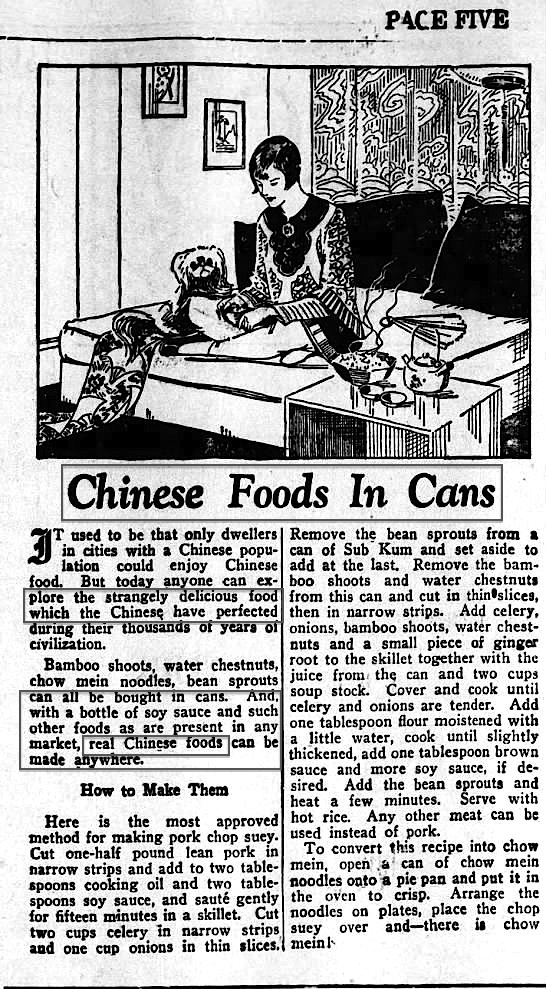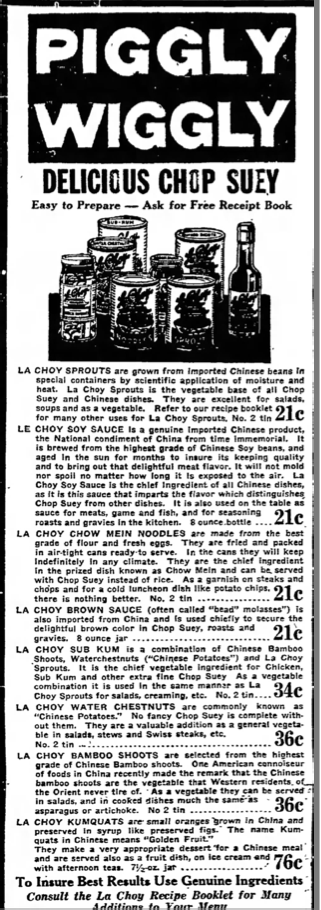In the early 20th century when there was a growing popularity of
chop suey and chow mein among Americans, two enterprising University of
Michigan students,Wally Smith and Ilhan New, neither of whom were
Chinese, hit upon the idea of creating and mass marketing a line of
prepackaged Chinese foods. Thus, La Choy, a coined name to generate
the feeling that the foods were ‘oriental’ was born in 1922. Wally
Smith, owner of a grocery store in Detroit wanted to sell fresh bean
sprouts. His friend, Illian New, a Korean American, was knowledgable
about how to grow bean sprouts, and they came up with the idea of
canning bean sprouts in glass jars. They expanded their canned products
to include a variety of Oriental vegetables using metal cans.
Newspaper
articles gave publicity to their products, such as one in 1929 telling
the public that these products now allowed “anyone to explore the
strangely delicious (italics mine) food.”
Today,
sales of La Choy and other brands of prepackaged Chinese food
ingredients have declined sharply, having been displaced by better
alternatives, but one could argue that La Choy contributed to its own
decline by popularizing home prepared Chinese food. As Jacqueline
Newman, editor of Flavor and Fortune, a periodical devoted to Chinese
cuisine, pointed out that in the 1920s, few non-Chinese knew how to
prepare Chinese dishes at home and that the introduction of La Choy
canned Chinese ingredients made a significant contribution to the
interest among non-Chinese in cooking Chinese food, admittedly limited
in scope, at home.
La Choy cleverly promoted their products by publishing free recipes booklets to guide the consumer, as shown below.
Ads of many grocery stores such as a chain in the South, Piggly Wiggly, prominently promoted La Choy products.
Whether
by chance, a touch of humor, or with malice aforethought, here are two
grocery store ads that placed LaChoy (and a later brand of prepackaged
Chinese foods, Chun King) next to dog food promotion. (Oddly, this La
Choy ad appeared in 1914, which precedes the 1922 founding of the La
Choy company)
An
ad in 1973 promoted “Oriental alternatives”…to American food, with the
slogan, Why not swing American with LaChoy? Discount coupons were an
added incentive.
An
ad focusing on the male-dominant Chinese society also encouraged
non-Chinese to have “a delightful change” from their usual cuisine by
having La Choy for dinner.
Chun
King, a rival to La Choy in the 1940s, was a line of canned Chinese
food products founded by Jeno Paulucci, the creator of Jeno's Pizza
Rolls and frozen pizza.
One of its ads below also emphasized
“Oriental for New Mood in Food” to encourage trying something different
from the usual meal. It also used celebrities such as Arthur Godrey to
plug their products, offered fashion news, and even discounts on nylons.
Sweepstakes with prizes such as trips to Hawaii also were offered by
Chun King.
Chun King promoted its line of Chinese foods sing a variety of
innovative and humorous ads created by a master of comedic parodies,
Stan Freberg,
Video of a Chun King ad:
"Break the American food habit of eating the same old thing every night."
"Would it hurt anyone of us to try something different tonight like chow mein?"
The
peak for the prepackage Chinese foods was sometime in the 1960s. By
the 1980s, larger corporations acquired smaller companies such as La
Choy. Chun King was purchased by ConAgra during the late 1980s, it
merged some of its product line with La Choy.
 After retiring from a 40-year career as a psychology professor, I published 4 books about Chinese immigrants that detail the history of their laundries, grocery stores, and family restaurants in the U. S. and Canada.
After retiring from a 40-year career as a psychology professor, I published 4 books about Chinese immigrants that detail the history of their laundries, grocery stores, and family restaurants in the U. S. and Canada.






















